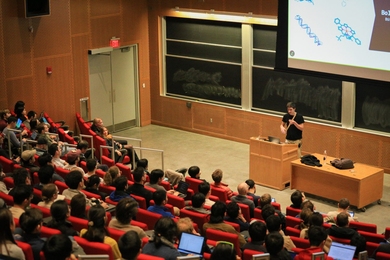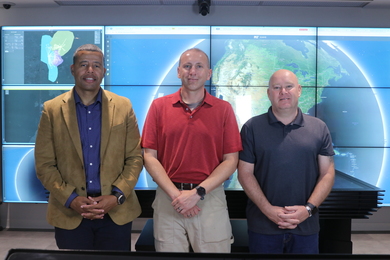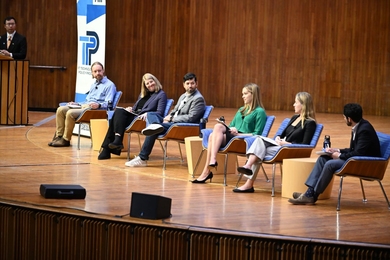It's not uncommon for an MIT faculty member or researcher to give a paper at a professional meeting, but when Professor Julian Szekely spoke recently in Tokyo it was more than a little unusual-and on more than one level.
Professor Szekely, a native of Budapest, addressed the Japanese Engineering Academy-in Japanese.
In addition, he brought the insights of an engineer to bear on a subject-the friction in US-Japanese relationships-that has not often, he said, been focused on by one familiar with physical sciences, technology and engineering-related issues.
"Since the root causes of the difficulties are related to technology," he told his audience on September 25, "engineering insights should be of major importance. . . . More specifically, we need to consider how technology is developed, nurtured, implemented, managed and transferred, what are the human questions and how this fits into the economic and political fabric of society."
For an American whose native language is Hungarian to make an hour-long speech in Japanese about the friction that exists between Japan and the United States reminded Professor Szekely of the story about the horse that played the violin, and he offered it as a "warm-up" story to the members of the Japanese academy.
"One isn't surprised at how well the horse does it. One is surprised that he can do it at all."
And more people ought to learn how, he said in a recent conversation with MIT Tech Talk.
"In our dealings with Japan at both the government and industrial management levels, the United States has been seriously handicapped by our ignorance of Japanese language, culture, customs and general mode of operation. Maybe the change of administration in Washington will allow us to refocus on these issues."
Professor Szekely, a member of the Department of Materials Science and Engineering, has been a frequent visitor to Japan for the past 20 years. In 1990, to prepare for a five-month sabbatical at Osaka University, he took a Japanese language course at MIT and has been working on those skills ever since. He has also been involved for some time with MIT's Japan Program.
Professor Szekely, internationally noted for his contributions to advanced materials processing technology through the application of mathematical modeling and optimization of complex dynamic systems, is a member of the National Academy of Engineering. He is considered an expert on the steel industry.
His invited talk, "Some Thoughts on US-Japanese Interactions in Engineering, Industrial Competitiveness, Research and Education," drew on his engineering and scientific contacts and on insights and impressions developed during a sabbatical leave at the University of Osaka.
He laid out his main message succinctly in his opening paragraph: "It is quite clear that major friction exists between Japan and the US. At the same time, we must also acknowledge the fact that our economies and, in fact, the fate of our two nations are closely connected by many ties. So these issues of friction have to be resolved to our mutual benefit."
He summarized the stereotypical views many in each nation hold. US politicians blame our economic plight on a "diabolic Japanese plot at world domination," on "Japan Incorporated," on cheap capital and inter-company collaboration that would be impossible in the US. On the Japanese side, he said, is the belief that the Japanese way of doing things "is simply superior," the feeling that Americans "are a rather disorganized lot, somewhat fat and lazy," who are "cry babies" and who "basically deserve all that is coming to them."
Stereotypes to be sure, Professor Szekely said, "but there is enough truth in them to make one think," he said in his talk, which touched on many of the "major asymmetries" he sees in the two nations in education, research, human resources and business management.
As to what should be done, Professor Szekely had several suggestions, all intended to bring together engineers from each country to work in a cooperative environment and to bring more attention "to technology and to the human components, including education and the development of human resources."
"Humans are the ultimate gatekeepers to technology transfer," he said. "The recently pursued US-Japanese Manufacturing Technology Initiative and the numerous joint study programs by the US National Research Council are excellent steps in this direction. However, much more could and should be done."
For a start, decision makers must learn more about the other country's language, culture and society, not only for the sake of improved US-Japan relations, but because that problem "may just provide the foretaste of other difficulties that we may be encountering with some of our other trading partners."
He called specifically for:
- Identifying a number of joint national projects in fields like environmental issues, industrial ecology and energy conservation on which Japanese and US engineers can work together closely over a period of time.
- ������Establishing joint appointments at leading universities where professors would spend one to two months a year lecturing, "preferably using the mother tongue of the students."
- ������Establishing research fellowships for talented US and Japanese students who would work under joint supervision of Japanese and US professors.
- Inviting senior industrial researchers to spend time at corresponding facilities in each country.
"These problems are important, their solution is critical not only to the continued well-being of our countries but also to the world as a whole. We do have the talent to solve them and as pragmatic, practical engineers, we should attend to this task," he concluded.
And, in keeping with his message that US engineers should become more knowledgeable about Japan, Professor Szekely took questions after his talk in Japanese.
A version of this article appeared in the November 12, 1992 issue of MIT Tech Talk (Volume 37, Number 13).





